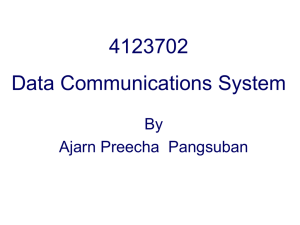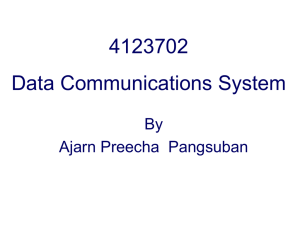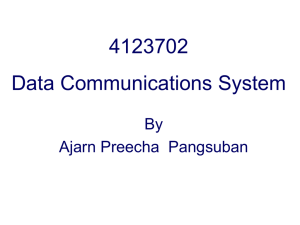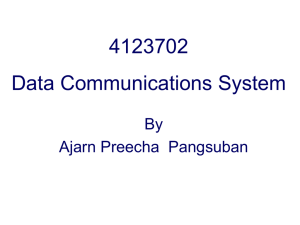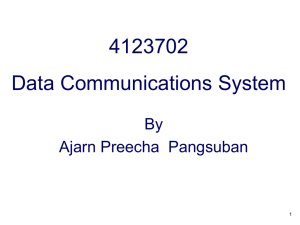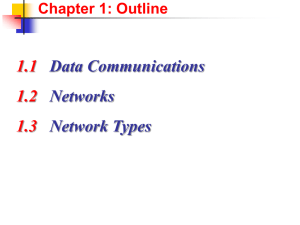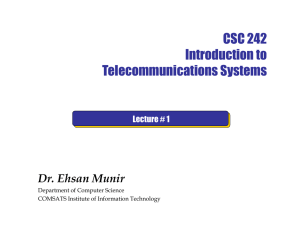ch1-Introduction
advertisement
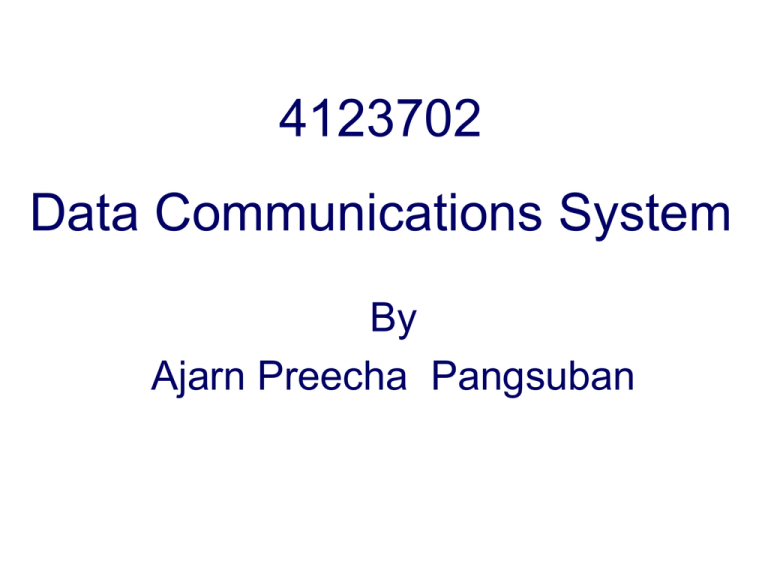
4123702 Data Communications System By Ajarn Preecha Pangsuban Part 1 Overview of Data Communications and Networking Chapter 1 Brief description of data communication, networking, and protocol standards Chapter 2 Network models 4123702 Data Communications System @YRU 2 Chapter 1 - Introduction Data Communication Why study data communications? Data communication is the exchange of data between two devices via a transmission medium Effectiveness depends on: Delivery Accuracy Timeliness 4123702 Data Communications System @YRU 4 Communication System Components 4123702 Data Communications System @YRU 5 Data Representation Text – represented as a bit pattern, a sequence of bit (0s or 1s); codes often used: ASCII; Extended ASCII; Unicode; ISO Numbers – represented by binary equivalent Images – bit patterns representing pixels Audio Video 4123702 Data Communications System @YRU 6 A Communications Model Transmission Network DTE DCE DCE DTE DTE: Data Terminal Equipment DCE: Data communication Equipment 4123702 Data Communications System @YRU 7 Simplified Communications Model 4123702 Data Communications System @YRU 8 Simplified Data Communications Model 4123702 Data Communications System @YRU 9 Simplified Network Model 4123702 Data Communications System @YRU 10 Direction of Data Flow Simplex – unidirectional; one transmits, other receives 4123702 Data Communications System @YRU 11 Direction of Data Flow (cont) Half-duplex – each can transmit/receive; communication must alternate 4123702 Data Communications System @YRU 12 Direction of Data Flow (cont) Full-duplex – both can transmit/receive simultaneously 4123702 Data Communications System @YRU 13 Networks A network is set of devices (nodes) connected by communication links (media) A node can be a computer,printer,or other device capable of sending and/or receiving data Link connecting the devices are often called communication channels Most network use distributed processing Advantages? 4123702 Data Communications System @YRU 14 Network Criteria (Standard) Performance – depends on number of users, type of medium, HW/SW Reliability – measured by freq of failure, recovery time, catastrophe vulnerability Security – protection from unauthorized access, viruses/worms 4123702 Data Communications System @YRU 15 Types of Connections Point-to-point – dedicated link 4123702 Data Communications System @YRU 16 Types of Connections (cont) Multipoint (Multidrop) – shared a single link 4123702 Data Communications System @YRU 17 Physical Topology The way in which a network is laid out physically 4 basic types: mesh, star, bus, ring May often see hybrid 4123702 Data Communications System @YRU 18 Mesh Topology Dedicated point-to-point links to every other device Has n(n-1)/2 physical channel to link n devices Devices have n-1 I/O Advantages? Disadvantages? 4123702 Data Communications System @YRU 19 Star Topology Dedicated point-to-point links to central controller (hub) Controller acts as exchange Advantages ? Disadvantages ? 4123702 Data Communications System @YRU 20 Bus Topology Multipoint configuration One cable acts as a backbone to link all devices Advantages ? Disadvantages ? 4123702 Data Communications System @YRU 21 Ring Topology Dedicated point-to-point configuration to neighbors Signal is passed from device to device until it reaches destination Each device functions as a repeater Advantages ? Disadvantages? 4123702 Data Communications System @YRU 22 Categories of Networks LAN – smaller geographical area WAN – large geographical area 4123702 Data Communications System @YRU 23 Local Area Network Usually privately owned and links the devices in a single office, building, or campus LAN size is limited to a few kilometers. LANs are designed to allow resources to be shared (hardware , software and data ) Today LANs to have data rates of 100 Mbps to 10Gbps Backbone Networks (BN), have a scale of a few hundred meters to a few kilometers. Include a high speed backbone linking the LANs at various locations. 4123702 Data Communications System @YRU 24 Figure 1-2 Local Area Network (cont) 4123702 Data Communications System @YRU 25 Figure 1-2 Local Area Network (cont) 4123702 Data Communications System @YRU 26 Wide Area Network WAN provides long distance transmission of data, voice, image, and video information over large geographical areas Comprise a country, a continent, or even the whole world (Interlink age of many LANs and MANs) Low data transmission rate (below 1 Mbps) Unlimited number of miles example: Internet Network 4123702 Data Communications System @YRU 27 Figure 1-4 Wide Area Network (cont) 4123702 Data Communications System @YRU 28 Internetworks Connection of two or more networks by the use of internetworking devices which include routers and gateways Internet is a generic term used to mean an interconnection of networks The Internet is the name of a specific worldwide network. 4123702 Data Communications System @YRU 29 Figure 1-5 Internetworks (cont) 4123702 Data Communications System @YRU 30 The Internet Collaboration of more than hundreds of thousands interconnected networks 1969 – started as ARPAnet, a small network of connected computers 1972 - Cerf and Khan – packet delivery and Transmission Control Protocol (TCP) Shortly thereafter – evolution of TCP/IP 4123702 Data Communications System @YRU 31 The Internet today 4123702 Data Communications System @YRU 32 Protocols and Standards Why do we need them? A protocol is a set of rules that governs data communication; the key elements of a protocol are Syntax – data formats and Signal levels Semantics – control information and error handling Timing – speed matching and sequencing Standards are necessary to ensure that products from different manufacturers can work together as expected. 4123702 Data Communications System @YRU 33 Standards Types – De jure (Formal) – legislated by an officially recognized body De facto – by convention or widespread use Standards Organizations Committees – ISO, ITU-T, ANSI, IEEE, and EIA Forums – special-interest groups that quickly evaluate and standardize new technologies regulatory agencies – FCC Internet Standards Drafts (6 month lifetime) RFC is an idea or concept that is a precursor to an Internet standard. 4123702 Data Communications System @YRU 34 Credits All figures obtained from publisher-provided instructor downloads Data Communications and Networking, 3rd edition by Behrouz A. Forouzan. McGraw Hill Publishing, 2004 4123702 Data Communications System @YRU 35
